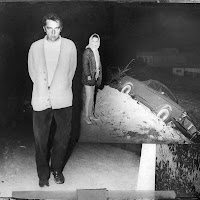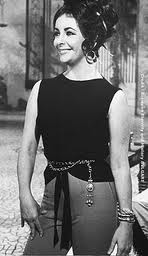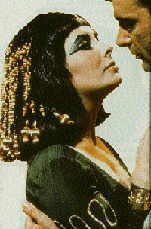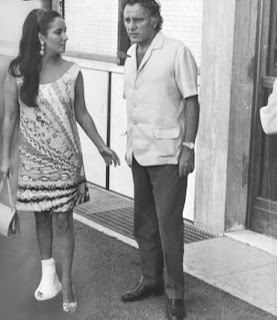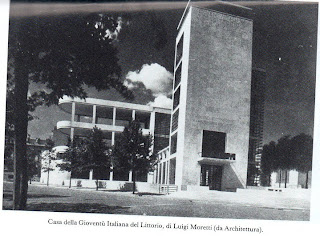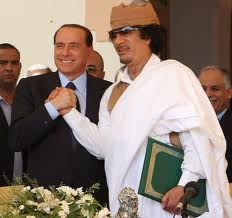 |
Buds? Italian Prime Minister Silvio
Berlusconi and Libyan leader
Moammar Gadhafi |
As the conflict in Libya ebbs and flows, we thought our readers might be interested in knowing more about Libya's historical relationship with the western nation that has been most significant in its past: Italy. More specifically, could the century-old relationship between Italy and Libya provide a ground for overtures that could lead to a resolution of the conflict?
Probably not. And here's why.
Italy's deepening relationship with Libya began 100 years ago, when Italy invaded the north African nation, a country dominated by the Ottoman Turks since the mid-1500s. When the colonial tie ended in the 1940s, the Italian and Libyan economies remained linked in a variety of areas, including oil, banking, arms and foreign trade. According to the 3/6/11
New York Times, Italy is Libya's largest trading partner. Nonetheless, in other ways the relationship has been congenial only since the mid-1980s; in 1986, Italian Prime Minister Bettino Craxi bought some Libyan good will by warning Moammar Gadhafi that the United States was about to bomb Tripoli. The two nations took another step forward in 1999, when a left/liberal Italian government apologized to the Libyan people and formally acknowledged its reprehensible conduct as an occupying colonial power. In Libya, the Italian premier condemned the killings of Libyan patriots and agreed to return to Libya the Venus of Leptis Magna, confiscated by Libya's Fascist-era governor, Italo Balbo, and given to the Nazi Hermann Goering. In 2008, Italy and Libya signed a "Friendship Treaty" with Libya (suspended by Italy last week), followed by a commitment by Eni, the Italian energy company, to invest billions in Libyan oil and gas. A mixed picture.
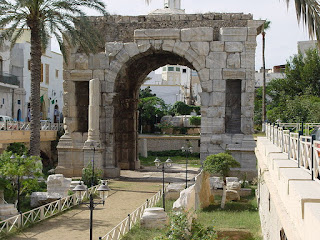 |
The Arch of Marcus Aurelius. As in Rome,
the occupying Italians chose to reveal the
arch by tearing down many nearby structures |
Let's go back a bit. The Libyan revolution of 1969, the revolution that produced Moammar Gadhafi, has been described by one historian as a "direct reaction to the negligence, torture, and disdain suffered by the Libyan Arabs during half a century of colonization." The following year, the Gadhafi government confiscated the properties of some 20,000 Italians living in Libya, while insisting that the expropriations were insufficient compensation for colonial damages. So let's return to 1911 and the colonial occupation and find out what happened.
Although the Italians presented themselves as "returning" to North Africa (it had been colonized by the ancient Romans, and Tripoli featured the Arch of Marcus Aurelius--see photo above left) and assumed that Italian soldiers would be welcomed as "liberators" from Turkish rule, the Libyans didn't see it that way. They made common cause with the Turks, who lost the war anyway, signed a treaty with Italy, and left in 1912.
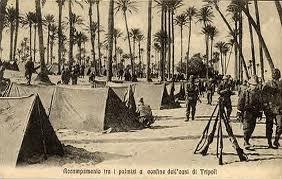 |
| The Italian army encamped near Tripoli |
But Libyan resistance to occupation did not end, and those opposed to Italian colonial status fought on--for another 20 years. The resistance was especially notable in the Cyrenaica region--the eastern part of Libya, and the area that today is under control of the anti-Gadhafi forces. During the 1910s, resistance was especially strong among the Sanusi, a tribal and religious movement/group with its own army that in 1916 declared itself an official state. Sanusi resistance in the east meant that the Italian state could not expand beyond the coast until 1922. There was resistance, too, in western Libya; in 1915, the Tripolitanian resistance had an estimated 15,000 fighters. The creation of a Tripolitanian Republic in 1920 delayed full Italian occupation of Tripolitania--meaning northern and eastern Libya--until 1925. Eastern Libya--Cyrenaica--remained at war with the Italians for another 7 years.
 |
| Resistance leader Umar al-Mukhtar |
The occupying Italians were frustrated and, one presumes, angry. As resistance escalated, so did deportation of troublesome Libyans, including several thousand who were packed off to Italy. Later, the entire population of the Jabal area of Cyrenaica was deported. In 1931, the Fascist regime in Libya constructed a 270 km barbed wire fence on the border between Egypt and Libya to limit aid to the resistance coming in from the east. That same year, it conducted a public execution of Umar al-Mukhtar, the 69-year-old resistance leader, before some 20,000 Cyrenaican tribesmen, thereby creating a martyr to the resistance cause.
In the late 1920s, perhaps still mystified that some Libyans failed to understand what Italy was trying to do in their country, the Fascist authorities decided to put local populations that supported the resistance in internment or concentration camps, isolating them from the rebels. Between 1930 and 1933, 16 internment camps were opened in the Cyrenaica region. About half the population of eastern Libya--about 100,000 people--was forced into the camps. Many of them were farmers and herders who consequently lost their occupations and their animals and were forced into inactivity. Of those interned, about forty percent--40,000 people--died. Most Libyan resistance to Italian rule ended in 1932, 21 years after the invasion.
The Italians had elaborate--one might say, grandiose--plans for Libya that went beyond subduing the local population. Among the sensible ideas was a road-building program designed to knit the eastern and western sections of the country together. Not so sensibly, Libya was to serve as a place for millions of unemployed Italian workers and underemployed Italian farmers. To create space for these destitute hordes, Libyans were forced to sell their lands to Italians, or the lands of rebel tribes were expropriated, the Libyans were put into camps, and the lands were given to Italians. In 1933, sheep-herdng families from Affile, outside Rome, arrived to take up expropriated lands. The areas dominated by the Sanusi--still without enthusiasm for the Italian occupation--were among the first to be dealt with in this way.
 |
Fascist bon vivant Italo Balbo
became the Governor of Libya in
1934 |
Despite the lofty goals, few Italians were resettled: by 1934 only about 1,000, and by the end of the decade, only about 30,000--well short of the "millions" anticipated. Most of this work was accomplished under Balbo, a strong-willed Fascist who had risen to heroic status by leading a squadron of aircraft from Italy to Chicago and back in 1933.
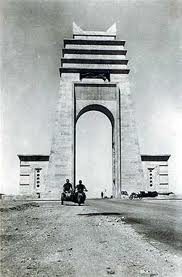 |
| Arch of the Fileni |
One can get a good measure of the high tension that surrounded the colonial project some 25 years after its beginnings by looking at Benito Mussolini's March, 1937 visit to Libya--his second of three, and by far the most successful. One of his goals was to celebrate Italian road-building projects in the country, particularly the essential and welcome Litoranea highway, tying east and west. To emphasize the road-building achievement and Italy's civilizing mission, Balbo had comissioned the Arch of the Fileni. The ceremony took place at night, the Arch illuminated by searchlights and flaming tripods, the Duce's appearance welcomed (or so it seems) by the shouts of Libyan soldiers, work crews, and native honor guards, some aboard camels. It was all very dramatic.
The highlight of Mussolini's visit was the Tripoli Trade Fair, where he was committed to showing that Italy, although a Christian country, was sympathetic to Islam. His first act, unveiling a statue of Julius Caesar that bore a curious resemblance to the Duce, seemed unlikely to contribute much to that goal. But the main event was yet to come. The following day Mussolini arrived at a sand dune outside Tripoli, riding a black stallion (he was an avid horseback rider). He was greeted by 2,000 Libyan calvarymen who cried out that he was "Founder of the Empire" (not exactly true), then presented him with the "Sword of Islam" before he galloped back to Tripoli for a major public address. He played to the Muslims in his audience and to the 9 million Muslims who were not part of the Italian north African empire.
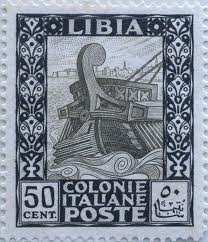
"Fascist Italy," Mussolini announced, "intends to guarantee the Muslim people of Libya and Ethiopia peace, justice, well-being, respect for the laws of the Prophet: and it wishes, moreover, to demonstrate sympathy towards Islam and towards Muslims the world over. Soon, with its laws, Rome will show how anxious it is for your future welfare. Muslims of Tripoli and Libya! Pass on my words through your towns and villages, right into the tents of the nomads. You know that I am temperate in my promises, but what I promise, I fulfill."
By this time most Libyans knew that Mussolini was anything but temperate, and the Duce's promises were greeted with considerable skepticism. A special dose of skepticism was reserved for Mussolini's claim to be "Protector of Islam," a role that for most Libyans ought properly to be assumed only by a Muslim.
Mussolini's less temperate side emerged full blown in only a few years, when he threw an unprepared Italian nation into a fateful alliance with Hitler's Germany. North Africa would become a key front in the ensuing world conflict, and the allied campaign in the region was well underway when Mussolini made his next visit to Libya in 1942. In 1943, Italian rule in Libya came to an end.
Bill
With thanks: The material in this post is gathered from the excellent essays in
Italian Colonialism, ed. Ruth Ben-Ghiat and Mia Fuller (Palgrave-Macmillan, 2005). See also
Bill's earlier post on more of the uglier side of Italian colonialization, including use of mustard gas.








